I had heard so much about birding around Sattal and Pangoot from several people that they became “must visit” destinations for me. So when my friend Ajit mentioned in our Birding Buddies (Ajit, Vignesh, Kumar and I) get together that he was considering a trip there, I needed no further cajoling.
After 8 months of waiting, the trip finally happened starting 29th Feb. It was an 8 days trip including the to and fro from Bangalore, with effectively 7 days of birding. The four of us had planned to be part of the trip. However a last minute medical emergency at home saw Vignesh sadly having to drop out.
We flew into Delhi from Bangalore and then took the overnight train to Kathgodam, reaching there by 5AM. We had booked our stay and birding with Hari Lama. He had sent a member of his team to pick us up from the Kathgodam railway station. A picture of us at the station was mandatory before we headed on 🙂 .

At Kathgodam Railway Station
The next 6 days were intense birding. The day usually started at 6AM when we would be out. It was still dark then. But the calls of the birds would start; morning calls of diurnal birds as well as the calls of the nocturnal birds like owls and nightjars just before they settled into their day roost sites. I certainly did not want to miss hearing all this. We would then head out to various locations for the first birding. We usually had 3 birding sessions during the day and then ended with sitting out till dinner listening to the nocturnal birds calling.
I will not get into the details of each of birding sessions. It is surely something that the three of us will cherish. Instead I will summarise, as a photo log, the sightings we had in the trip. Sattal and Pangoot are at a distance of roughly 40kms and are at different elavations. So the sightings to be expected at these locations also differ. Hence I will cover the sightings separately. In this post, I will cover that of Sattal.
Sattal
It was not strictly only in Sattal that we birded. It was various locations around the area. These includes places like Chanfi, Sattal, Bhimtal, Bhawali etc. The bird sightings that I share below is from across all these spots. In this post, I will keep the “Royals” till the last.
One of the most wide-spread birds is Red-billed Blue Magpie. It is also a bird whose beauty cannot be ignored, especially in flight and when it lands. We were mesmerised by it. They are also quite noisy; well makes it easy to spot them 🙂

Red-billed Blue Magpie
Another “omnipresent” bird is the Blue Whistling Thrush. It looks drab if you see it in the shade. But if you were to get in the sun, one will then appreciate its beauty. Here is a poor picture of it.

Blue Whistling Thrush
For me, the outstanding element on this bird, is its song. I would be out by 6AM just to hear it singing. It usually only sings at dawn and dusk. If you visit, it’s singing is not be missed!
Another very common bird is the Rufous Sibia. Look for it darting around, It can also be seen putting its head into the flowering Rhododendrons.

Rufous Sibia
Sparrows, yes sparrows! Coming from a large city where it is not easy to get to see sparrows, it was a pleasure to see and hear them in plenty. The sparrows that we see around usually are the Russet Sparrows.

Russet Sparrow (M)
The Bulbuls that we encountered the most were the Himalayan Bulbul and the Himalayan Black Bulbul.

Himalayan Black Bulbul
We did however see the Red-vented Bulbul and on one occasion also saw an Ashy Bulbul.
We saw good abundance of Woodpeckers. The most prolific was the Brown-fronted Woodpecker.

Brown-fronted Woodpecker (F)
One of the loudest was the Grey-headed Woodpecker. Almost always, its presence nearby was announced by its call.

Grey-headed Woodpecker (F)
We also saw several Lesser Yellownape. They were a sight to behold with their colour. See what I mean?

Lesser Yellownape (F)
The less abundant ones we encountered were the Himalayan Woodpecker, Greater Yellownape and Rufous Woodpecker.

Himalayan Woodpecker (M) 
Great Yellownape 
Rufous Woodpecker (M)
Then there was a Speckled Piculet that spent almost 5 minutes doing its feeding “dance” in front of us on an eye level branch; enthralling to watch it! Look for it in the short video later in this post.

Speckled Piculet
A constant call that you will hear in the background is that of the Great Barbet. If you observe it closely, you will that they too are really colourful. They are also easy to spot almost anywhere one goes.

Great Barbet
There is no dearth of colourful birds in this part of the country. The Blue-winged Minla and the Red-billed Leiothrix (almost sounds like a character from the Asterix comic series 😀 ) are other species sure to catch ones fancy.

Blue-winged Minla 
Red-billed Leiothrix
There were also quite a few warblers around. The most common one was the Grey-hooded Warbler.

Grey-hooded Warbler
They are also very vocal, their call being quite melodious to listen to. Giving them company at times were the Lemon-rumped Warbler and the Buff-barred Warbler. We also got good views of the Whistler’s Warbler.
Another fascinating bird to watch and also to listen to, was the Rusty-cheeked Scimitar Babbler.

Rusty-cheeked Scimitar Babbler
Unlike other Scimitar Babblers that I have seen, these ones were not shy or afraid. They came out in the open a lot and also went about their foraging even when we observed them from quite close by. We also saw or heard them at almost all places we visited. At times we would see them perched on top of a tree and calling.
Nuthatches are very different looking and behaving birds. It is funny to see them slowly making their way down the trunk or branch of a tree in spirals. The most common ones we saw were the Chestnut-bellied Nuthatch.

Chestnut-bellied Nuthatch (F) 
Chestnut-bellied Nuthatch (M)
We did also see the White-tailed Nuthatch near Nainital on an occasion.
The Treecreepers go in the opposite direction to the Nuthatches, i.e. up the tree trunk. The one we saw was the Bar-tailed Treecreeper. They were less abundant than what I was expecting.
There were also a number of Sunbird species that we saw. The one I had particularly wanted to see was the Fire-tailed Sunbird. It however gave us a fleeting glance only. But even in that, its bright colours stood out. The other Sunbirds include the Purple Sunbird, Black-throated Sunbird, Green-tailed Sunbird and the Crimson Sunbird. Only the last two obliged with some opportunities to photograph them.

Green-tailed Sunbird (F) 
Crimson Sunbird
The natural streams gave us ample time with its denizens. The Forktails here were the Spotted Forktail

Spotted Forktail 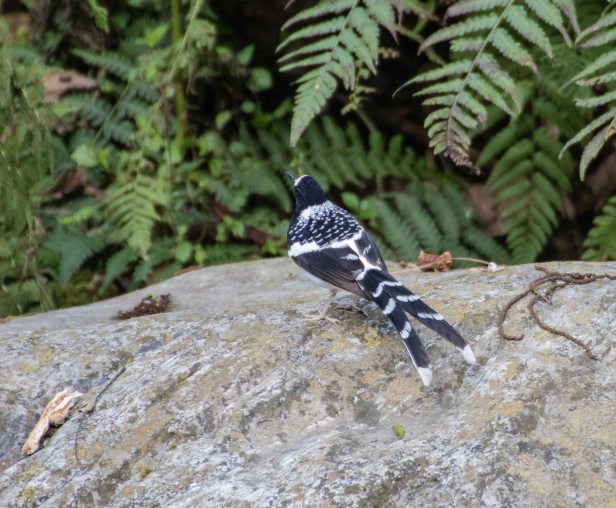
Spotted Forktail
and the Slaty-backed Fortail which was a bit more shy than its cousin.

Slaty-backed Forktail
The other residents included the Plumbeous Redstart and the White-capped Redstart.
We also saw the Small Niltava, White-throated Fantail and the Yellow-bellied Fantail near the stream, though the first two were also seen elsewhere.

Yellow-bellied Fantail
Here is a Rufous-bellied Niltava that we saw near our place of stay.

Rufous-bellied Niltava
The most vocal group of birds were the Tits; and there were plenty of them. They included the Cinereous Tit, Himalayan Black-lored Tit and the Green-backed Tit.

Green-backed Tit
Keeping them company was the Black-throated Tit. Here is one that was seen busy collecting nesting material. We noticed it building its nest besides a pathway.

Black-throated Tit
In the Flycatchers, most of them usually return in Spring/Summer for breeding. I had particularly wanted to see a Slaty-blue Flycatcher. Here is the female of it.

Slaty-blue Flycatcher (F)
But the most numerous were the Grey-headed Canary Flycatcher. It was charming to watch them fly off a perch and come back to it again and again. Such a typical Flycatcher behaviour. We also saw the Verditer Flycatcher. Both these seem to have returned early this year. The other we saw was the Rufous-gorgeted Flycatcher.
Giving them close company were the Himalayan Bluetail. They were always shy and cautious; a typical Bush-Robin behaviour.

Himalayan Bluetail (F)
Another common bird everywhere was the Oriental Turtle Dove.

Oriental Turtle Dove
In one particular session, we were pleasantly surprised by a flock of around 40 Pin-tailed Green Pigeons that landed on a tree right in front of us.
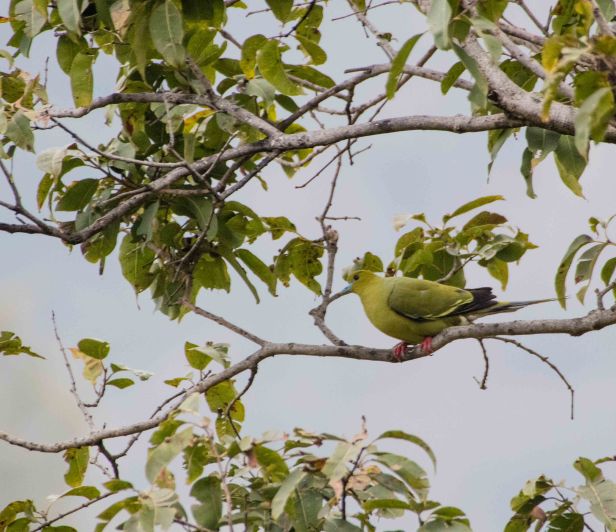
Pin-tailed Green Pigeon (F)
The Minivets were a constant sighting in almost all places we visited, the common seen being the Long-tailed Minivet.
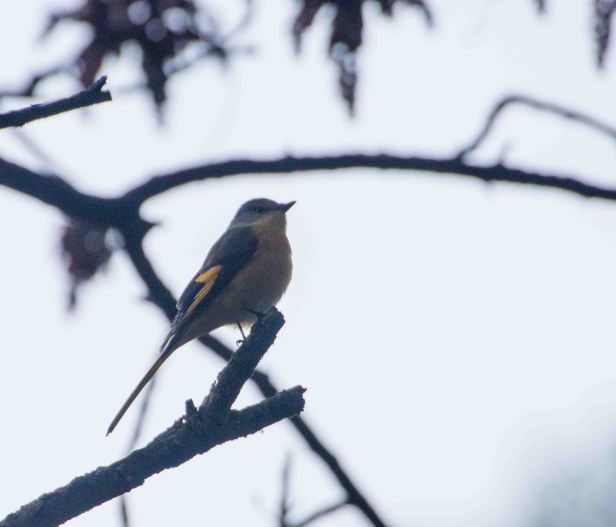
Long-tailed Minivet (F)
The much rarer one was the Scarlet Minivet. We saw it only on two occassions.

Scarlet Minivet (F)
A group of birds that were well spread and not difficult to see were the Laughingthrushes. The most common bird (period) was the Streaked Laughingthrush.

Streaked Laughingthrush
And they had so many varied calls! The other common one was the White-throated Laughingthrush. The one which we heard a few times but saw it only once was the White-crested Laughingthrush.

White-crested Laughinthrush
But the most shy ones were the Rufous-chinned Laughingthrushes. We were lucky to have caught a view of them in our last session. They quickly darted back into the undergrowth.

Rufous-chinned Laughingthrush
A bird that you will hear and many times see is the Slaty-headed Parakeet.

Slaty-headed Parakeet (M) 
Slaty-headed Parakeet (F)
The other parakeet we saw was the Plum-headed Parakeet. They were however localised to a particular. There we saw a flock of them raiding a wheat field. I am sure the farmer would not have been pleased with their behavious 🙂 .
There were several Thrushes we saw. The most common one was the Black-throated Thrush.

Black-throated Thrush (M)
The other one that saw several of was the Chestnut-bellied Rock Thrush.

Chestnut-bellied Rock Thrush (F)
But the most pretty one for me was the Chestnut Thrush. The one below had claimed an entire Rhododendron tree for itself 😀 . See the video later in the post to see it raiding the flowers.
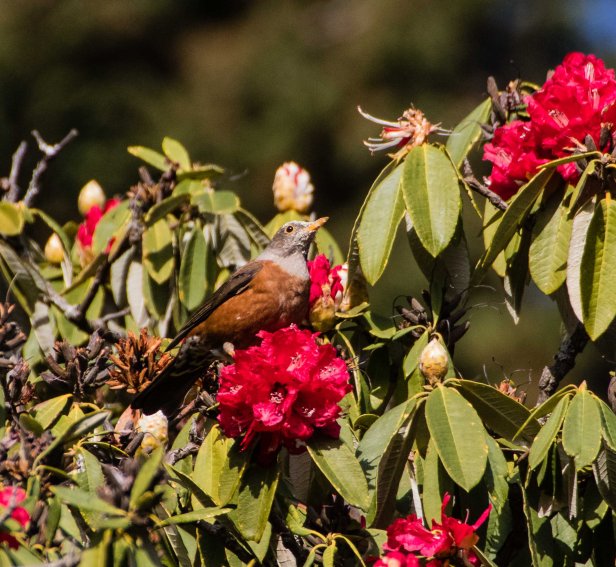
Chestnut Thrush (M)
Coming to raptors, there were several we saw. The one we saw at a couple of places was the Eurasian Sparrowhawk.

Eurasian Sparrowhawk
Unsurprisingly there was only a single Black Kite we saw during the entire trip. The most common one seemed to be the Steppe Eagle. We saw them at several places. But the raptors that drew our attention the most were clearly the Owls. And most gave us fantastic views. The biggest we saw was the Brown Wood Owl. Here it is at its day roost.

Brown Wood Owl
The most vocal and I think most numerous, were the Asian Barred Owlet and the Collared Owlet.

Asian Barred Owlet 
Collared Owlet
We even got to see the false eyes on the back of the Collared Owlet. What wonders nature holds!

Rear view of Collared Owlet
We however dipped on the Tawny Fish Owl. Hari said that it was likely that it had retreated into the forest interiors as breeding season was beginning. At night we could also frequently heard the call of the Mountain Scops Owl. The Collared Owlet also was not one to be left behind. Its calls were most heard at dusk and dawn.
The Finches that were on my list and got to see as well, were the European Goldfinch and the Yellow-breasted Greenfinch.
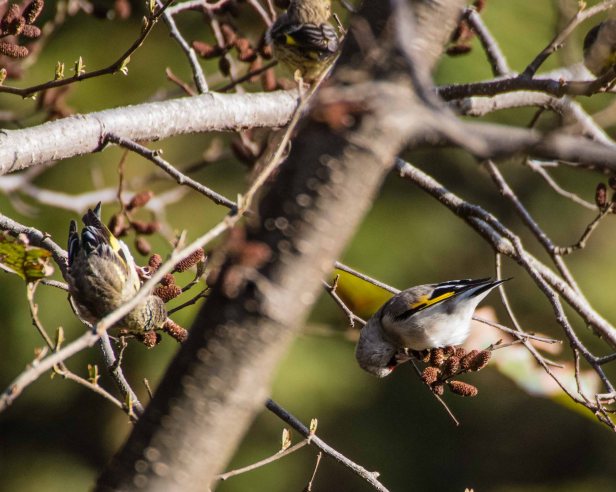
European Goldfinch 
Yellow-breasted Greenfinch
The other nocturnal birds, besides the Owls, were the Nightjars. We got excellent views of a Large-tailed Nightjar on a tree top right next to our room. The other was the Grey Nightjar whose call was heard at dawn on all days.
Now for the Royals! Why Royals? Well, for me these were just outstanding in their colours and their overall “presence”. So here they are.
Kalij Pheasant

Kalij Pheasant (F) 
Kalij Pheasant (M) 
Kalij Pheasant (F) 
Kalij Pheasant (M)
Black Francolin

Black Francolin (M) 
Black Francolin (M)
Common Green-Magpie

Common Green-Magpie 
Common Green-Magpie 
Common Green-Magpie
Red Junglefowl

Red Junglefowl
Nature Around
It is not just the fauna that is rich in these parts and worth taking in. The flora is equally impressive. The whole place has a way of wanting you to slow down. Each place we visited, it was pleasurable just being there, even if there were no birds. Here are some photos of the places I took:
Here is us with Mr. Hari Lama.
Video
Here is a short video I put together of some of the birds:
Other Info
I feel birding in the region is not that easy. The fantastic bird photos that one sees in various social media and to some extent even in this blog post, may give the impression otherwise. Well, my experience there in this trip makes me say so.
First coming to the pictures; if you are thinking of the good pictures of the “Royals”, then those were taken from a hide. Essentially a hide, for those who do not know, is a place that you get to observe birds from a covered cabin. The birds are enticed to come to the area by providing them water and/or food. In the hide that we visited, they had both food and water.
The bird hides are great places if your focus is getting good photographs. To aid this, there are also perches set up to give a “natural” feel to the photograph. We met a few guests who were focused on getting good photographs of the birds. So they spent a significant amount of time in hides. For birders, like me, it is nice for a while, as you get to observe the birds that visit more closely and with more time. However it does not give the same excitement and natural feel as sighting the same bird in the “true” wild. There is also the matter of “are we doing the right thing for the bird” question since it is a bit of an un-natural way of getting its food. Well, this is best left to one’s own judgement. One will need to strike a balance from one’s own viewpoint. Of all the bird species that we got to see during the trip, there were only a very limited set of bird species that came to the hide. All the rest, as well as the ones we saw in the hide, were seen in their natural surroundings.
Bird activity is the best in the first half of the day. On every post noon session, we found the bird activity was pretty limited. There were times when we did not hear any calls or have sightings at all. Hari told us that he has been seeing an over decline in bird density over the years, given all the “development” being done by humans.
Many of the bird species, especially the Bush Robins, Bush Warblers, Tesia, Rubythroat etc. are very shy birds. They prefer to stay in the undergrowth. One needs to have a lot of patience and stay put in its habitat to catch a glimpse of it. Owing to this, people usually use calls to lure them out. We chose not to do so. So we visited their habitats several times in a bid to see them. We were lucky with some. But we also dipped on a few. So you will need to decide which way you want to go. If you do decide to play calls, then please do so reasonably.
We had visited towards the end of winter. Many of the winter visitors were still around, though less in number, and the summer visitors were not yet in. Summer will allow one to see the flycatchers, like the Ultramarine Flycatcher, that return to breed. It will also bring in the very popular Long-tailed Broadbill. This is also a period when they visit the “Sattal Studio” to take their day showers in the natural stream, thus making it a favourite jaunt for photographers.
Check the weather forecast. This year has seen some nonseasonal rains. In fact the last two days of our trip saw it raining the whole day. So we could not do any sessions at sites. We just stayed in the room, enjoyed the rain and went for short walks whenever the rain stops for a short bit.
Even if you are a photographer, try and look at the birds through a binocular 🙂 . It always blows me away when seeing them through one.
Plan for atleast 3 days of full birding in and around Sattal.
Last but not the least, remember that you are in the Himalayan foothills. Don’t forget to enjoy the nature all around. The serenity and beauty is not to be missed.
Interested in knowing about birding in Pangoot? You can read our experience around Pangoot here.


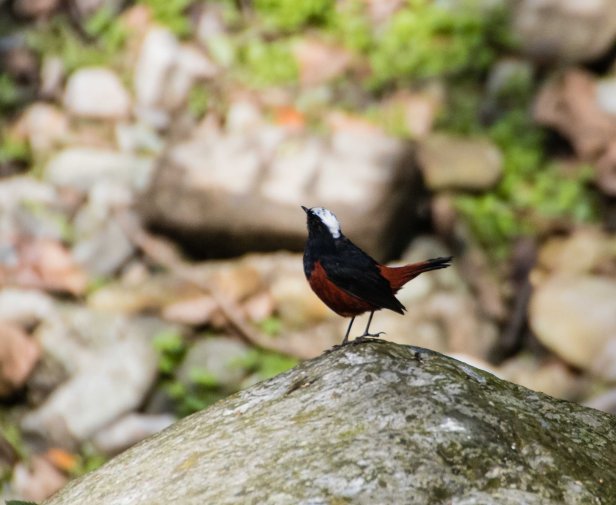



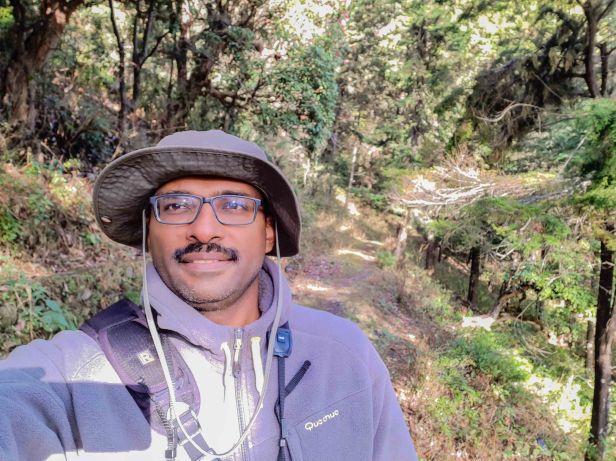
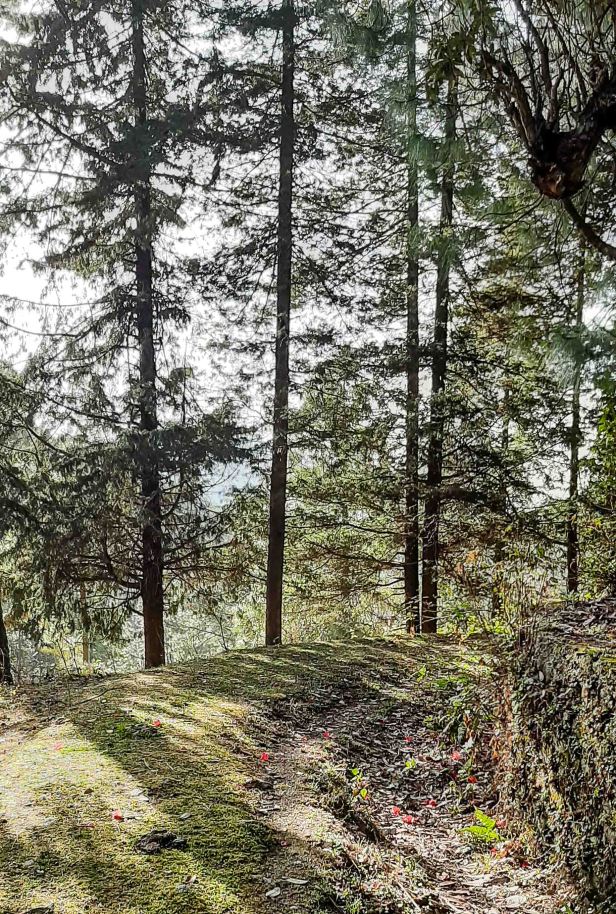




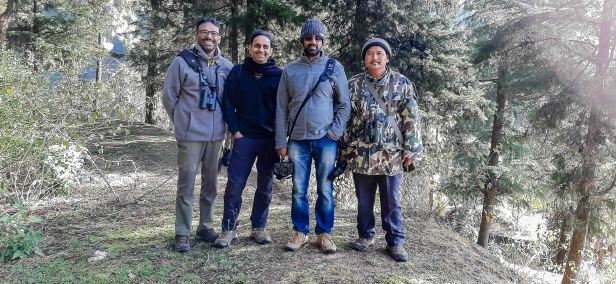
WoW, Amazing ! It definitely calls for a visit. Happy Birding !🙂
-Regards Parvez
On Tue, Jul 21, 2020, 11:00 Mad about Birding and Travel wrote:
> madaboutbirdingandtravel posted: ” I had heard so much about birding > around Sattal and Pangoot from several people that they became “must visit” > destinations for me. So when my friend Ajit mentioned in our Birding > Buddies (Ajit, Vignesh, Kumar and I) get together that he was considering > a” >
LikeLiked by 2 people
Definitely a region that I would recommend for birding. A great place to start seeing the Himalayan species of birds.
LikeLiked by 1 person
Do you recommend any tour company I can arrange with this trip?
LikeLike
If it is birding that will be the main intent of the trip, i would recommend contacting one of the many birding guides. They are usually able to put a package for you to suit your needs
LikeLike
That was a great birding trip.
LikeLiked by 2 people
It certainly was Sunith
LikeLiked by 1 person
Hmm. Can I reblog this
LikeLiked by 2 people
Sure you can Sunith
LikeLiked by 1 person
Awesome. Pinned it
LikeLiked by 1 person
Superb write up…it’s a place high on my list… your blog definitely going to help me with my planning and lifer list…🙂
LikeLiked by 1 person
Rahul, you will be definitely blown over when you visit! I expect even better pics from you 😀
LikeLike
Wow! Such gorgeous birds and photos! Very informative post.
LikeLiked by 1 person
Thanks Rethy. I had really enjoyed watching them
LikeLike
I really enjoyed reading this. Many of these are regular visitors to our home in a village near Bhimtal. Only after living here have I become truly interested in birds. I liked your straight forward easy narration and great pics.
Would you know a sight that helps identify bird calls? We hear them more than we see them and it would be great to be able to match the calls to the birds. Thanks
LikeLike
Thanks Payal for commenting. You can try xeno-canto.org for bird calls. They have one of the best repositories.
LikeLike
Superbly curated and crafted blog. Enjoyed reading it,
LikeLiked by 1 person
Thanks Harish!
LikeLike
Amazing pictures. Next time you are in Sattal come to Sattal Forest Resort. Most of the birds just hang around here in their natural surroundings.
LikeLike
Thanks Usha
LikeLike
I wanna thank you, my friend, for this lovely report of your birding trip. I´m going to Sattal on March 2023 and I´m still planning my days over there. You helped a lot and if you ever want to come to Brazil for birding, give me a call. I can give you the best info for enjoying your trip here. Add me on instagram https://www.instagram.com/klassmannphoto (@klassmannphoto) and let´s talk.
Best regards from Brazil,
Lucas Klassmann.
LikeLiked by 1 person
Thanks Lucas for the kind words. I hope you have a great trip coming March.
Yes, Brazil is definitely one of the destinations I have in my list of places to bird. I will take you up on your offer when I plan a trip there 🙂 . I have followed you on instagram. You have stunning photos!
LikeLike